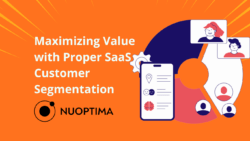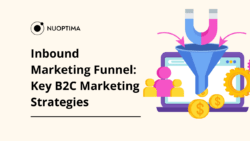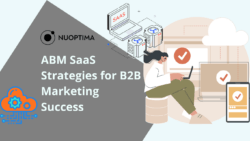The SaaS industry has grown by around 500% over the past seven years [1]. But how do you get a piece of that cake? It’s simple – by understanding and optimizing your SaaS sales process, stage by stage.
While the SaaS industry is pretty lucrative, many businesses still struggle to fulfill their revenue potential. But you’ll learn how, thanks to our guide, which explains everything about the B2B SaaS sales process and provides actionable tips for increasing your revenue.
This video delves into the complexities of attributing sales in the digital marketing landscape and uncovers the hidden channels influencing your sales outcomes.
How Optimized B2B SaaS Sales Process Increases ARR
An optimized B2B SaaS sales process can significantly increase your Annual Recurring Revenue (ARR) by streamlining the path from prospecting to closing sales, enhancing customer retention, and maximizing upsell opportunities.
This is exactly how the sales process for SaaS businesses impacts your ARR at each stage:
- By targeting leads that fit the ICP (ideal client profile), you make sure that your marketing efforts concentrate on prospects with the highest potential to convert and remain long-term customers, consequently increasing ARR.
- Producing high-quality, relevant content that solves specific problems for the target audience can attract more qualified leads, improve the SaaS conversion rate, and contribute to ARR growth.
- Implementing automated lead scoring and segmentation lets you quickly identify high-potential leads and focus your SaaS sales efforts on opportunities with the greatest revenue potential. If you’re looking for a more targeted approach to acquiring qualified leads, partnering with a specialized SaaS lead generation agency can provide the expertise needed to accelerate your sales funnel.
- Tailoring communication based on the lead’s behavior and needs increases the likelihood of conversion, which directly influences your SaaS ARR.
- Utilizing CRM (Customer relationship management) tools that automate follow-ups and manage SaaS sales pipelines reduces the sales cycle length and enables faster revenue realization.
- Offering personalized demos or free trials that demonstrate value significantly increases conversion rates and has a positive impact on your SaaS sales process and revenue.
- Monitoring key SaaS sales metrics (e.g., conversion rates, average deal size, sales cycle length, customer churn) helps you identify bottlenecks and areas for improvement in every stage of your B2B SaaS sales process. This leads to a more effective B2B SaaS sales strategy and higher ARR.
- Regular analysis of your B2B SaaS sales process and customer feedback enables ongoing refinement, ensuring it remains aligned with customer needs and your SaaS go-to-market strategy.
- A smooth onboarding process and comprehensive educational resources ensure that customers quickly realize your SaaS product’s value, reducing churn rates and securing ARR.
- Providing proactive customer support and regularly engaging with customers to gather feedback and offer solutions enhance customer satisfaction and loyalty, leading to renewals and opportunities for upselling and cross-selling.
- You can significantly boost ARR from existing customers by focusing on increasing the customer lifetime value through upselling and cross-selling.
- Offering tailored upgrades or additional features that meet customers’ needs drives further revenue growth.
Additionally, software aggregators SaaS can play a crucial role in optimizing your sales strategies by consolidating various tools and services into a single platform, thereby simplifying the sales process and enhancing efficiency.
SaaS Sales Process: Stages
To optimize your B2B SaaS sales process, you need to understand every stage of it and what customers expect along the way.
These SaaS sales process stages all have distinct features, and you need to understand their purpose in the broader context of acquiring and converting potential customers. Let’s see how these stages stand out from each other:
Stage 1: Lead and Demand Generation
Lead and demand generation are equally important for the B2B SaaS sales process and are basically a foundation. However, there are important differences between these two approaches, and it’s best to utilize both strategies to generate more customers.
Lead Generation
Lead generation is the process of identifying and capturing information about potential customers (leads) who have shown interest in a SaaS product.
From January 2018 to November 2022, the average cost per lead (CPL) for paid channels in the U.S. B2B SaaS sector was approximately $310. In contrast, the CPL for organic channels was nearly $165. [2] That’s almost half as much for paid channels, and we haven’t yet talked about the quality of those leads.
Remember: the primary goal is to gather enough data to enable personalized follow-up efforts, such as sales calls or targeted emails, which can convert leads into paying customers. Key activities include:
- Form submissions
Encouraging visitors to fill out forms on SaaS landing pages in exchange for valuable resources like eBooks, whitepapers, or webinars, thus capturing lead data. The more detailed your forms are, the easier it will be for you to qualify leads in the next stage of the SaaS sales process.
- Email marketing
Offering newsletter subscriptions to gather email addresses, allowing for regular communication and nurturing.
- Trial sign-ups
Provide free trials of the SaaS product to collect information about potential customers who are interested enough to try it.
Demand Generation
Demand generation encompasses all marketing activities that create awareness and demand for a product. Unlike lead generation, which focuses on capturing lead data, demand generation is concerned with building relationships and making a positive brand perception over time. Key strategies include:
- Content marketing
Creating and distributing educational content that addresses customer pain points and positions the SaaS product as a solution is a key strategy in SaaS product marketing, thus building brand credibility and trust.
- SEO and PPC
Enhancing online visibility through search engine optimization and paid ads to reach a broader audience and generate awareness.
- Social media engagement
Using platforms like LinkedIn, Twitter, and Facebook, you should engage with potential customers, share content, and promote discussions around your SaaS product.
Differences Between Lead and Demand Gen
As you can see, the main difference between lead generation and demand generation lies in their focus and objectives.
Demand generation is about creating a need or interest in the product and nurturing a positive brand relationship, often without immediate concern for capturing specific customer data. It aims to pull a broad audience into the sales funnel through general awareness and education.
In contrast, lead generation is more tactical. It aims to convert interest generated by demand generation into actionable insights by obtaining contact details, which can then be directly targeted through specific sales and marketing efforts.
Together, these strategies form a comprehensive approach to the SaaS sales process, ensuring immediate sales, long-term brand loyalty, and customer engagement.
Stage 2: Lead Qualifiaction
Maybe the most important stage of the B2B SaaS sales process, lead qualification, is all about evaluating leads to determine how likely they are to become customers.
This step helps B2B SaaS sales teams prioritize their efforts on leads that are most likely to convert. For example, Nuoptima closed £90k & got 568 qualified leads by holding a month-long SEO webinar series. This is the perfect example of how targeted and valuable content (in this case, a series of webinars) attracts qualified leads ready to buy from you if you do it right.
However, to completely optimize your SaaS sales process, you need to understand some important differences between Marketing Qualified Leads (MQLs) and Sales Qualified Leads (SQLs).
MQLs
MQLs are leads that have shown a level of interest, suggesting they are more likely to become customers than other leads. This qualification is typically based on engagement with marketing efforts, such as:
- Content engagement
- Website interactions
- Event participation
While MQLs haven’t interacted with your sales team yet, they’ve obviously taken actions that indicate a potential to purchase in the future. Your marketing team can use lead scoring models to rank these leads based on their activities and engagement levels.
SQLs
SQLs are leads your sales team has already interacted with, and they think that those leads are ready for a direct sales approach. This transition from MQL to SQL involves additional criteria and direct interaction, such as:
- Leads that explicitly express interest in buying or learning more about the product through direct communication channels.
- Leads whose business needs and potential pain points align closely with the solutions offered by the SaaS product.
- Leads with the budget authority and timeline fit the criteria for making a purchasing decision.
Note: The SaaS sales team typically conducts an initial contact or a detailed discussion to confirm these qualifications before classifying a lead as an SQL.
Pro tip:
Focusing on MQLs and SQLs helps you create an effective B2B sales process.
By identifying MQLs, the marketing team can nurture leads in a targeted way until they are warm enough to hand over to the sales team. SEO is one of the best channels to acquire MQLs, as it produces almost 5x higher ROAS than paid channels [3]. Organic is where the long-term success is, and you should plan your marketing budget with this in mind.
Once leads become SQLs (and 13% of MQLs do![4]), the sales team can apply more focused resources and personalized strategies to convert them into paying customers. This approach ensures that the sales funnel is optimized for conversion, reducing the time and resources spent on leads less likely to result in sales.
Get Qualified Leads for Your B2B SaaS Sales Pipeline
One of the best ways to get MQLs for your B2B SaaS sales pipeline is to engage with a marketing agency that knows the ins and outs of your industry. And that’s where Nuoptima steps in.
With B2B SaaS marketing services that range from SEO, PPC, and PR to copywriting and email marketing, our clients have managed to rank high on Google, get qualified leads, and close deals. B2B SaaS marketing is complex and requires understanding your product and, more importantly, your ideal clients.
As an award-winning marketing agency, we take pride in achieving tangible results for B2B SaaS clients simply because we not only understand marketing, but your SaaS sales process as well.
For example, one of our clients, Zelt, achieved more in 1 month of our SEO services than some companies do for months or even years. They had a 300% increase in traffic and 500 organic keywords that constantly drive conversions. But wait until you hear this!
Contrary to popular belief, you don’t need hundreds of backlinks to achieve these results because we’ve got them with only 10 backlinks.
So, if you want actual results, not numbers on a page, book a complimentary call, and let’s see how we can help you get qualified leads fast.
Stage 3: Discovery
The discovery stage of the B2B sales process is all about building a relationship with potential clients and tailoring your sales approach to align better with their specific circumstances. It’s where the sales team engages directly with potential customers and gathers information you don’t have already. How does the discovery stage of the B2B sales process roll out?
- It often begins with an initial meeting where your sales team opens a dialogue and builds a report with a potential client.
- The core is to understand your client’s business needs deeply, and you can achieve that by asking insightful questions about their current operations, pain points, and challenges. For the SaaS sales process, this means focusing on solutions clients already use, gaps in those solutions, and client KPIs.
- It is crucial to identify the decision-makers within the organization and any key influencers who might affect the purchasing decision. Understanding these individuals’ roles helps you tailor subsequent communications and demonstrations.
- Discussing the budget early in the process helps align expectations and ensures that proposed solutions fit the client’s financial constraints. It also saves time by qualifying out prospects who may not have the necessary funds to afford the solution, especially for the enterprise SaaS sales process.
- Understanding the client’s timeline for implementation and any driving factors behind it (such as end-of-fiscal-year budgeting, compliance deadlines, etc.) is essential for crafting a proposal that meets their urgency.
The discovery stage of the SaaS sales process is important for two reasons: you use the resources on leads that have a higher chance of converting, which influences the closing stage, and you set the stage for upselling and increasing customer lifetime value (CLV).
Stage 4: Solution Presentation
After gathering insights during the discovery stage of your SaaS sales process, it’s time to demonstrate how your SaaS product solves client’s problems. It’s all about showcasing the value and benefits of your SaaS solution in a clear manner. And we can give you some tips to make this stage a breeze:
- Customize the demonstration of your SaaS product based on the information you’ve gathered in the discovery stage of the sales process. Make sure that your product’s features and capabilities directly relate to client’s specific problems and help them improve their processes. For example, if the client is struggling with data integration, the demo should focus on the ease and capability of your software’s integration features.
- Make your product demonstration as interactive as possible. You should encourage questions and feedback to make sure client feels involved. Plus, you can address and concerns and objections as they arise.
- Include relevant case studies and success stories similar to clients to boost your credibility. Demonstrating success in similar scenarios reassures the client that your SaaS product is effective in similar circumstances.
- Your solution presentation should always clearly articulate the return on investment (ROI) the client can expect. You should not only talk about cost savings but also about increased efficiency, productivity, and scalability your SaaS product offers. Make sure to quantify these benefits in terms of time and financial metrics.
One great way to tackle this stage of the sales process for your SaaS company is to offer interactive demos. On average, the range for B2B marketing channels’ CTR is 0.7%—3.7%. The interactive demo’s CTR range is 8.18%—32.25%. [5] These statistics show that it’s a great and innovative tool your SaaS company can use to capitalize on while competitors haven’t discovered it.
Stage 5: Negotiation
The negotiation stage of the B2B SaaS sales process is all about finalizing the terms between the client and your sales team. After the end of the negotiation stage, both parties should feel they are getting a fair deal. This will lead you to a successful sale and a strong, enduring relationship. What are the elements in the negotiation stage you need to cover with clients?
- You need to discuss the price and it’s often a central focus of the negotiation stage in B2B SaaS sales. It’s because pricing can often be complex due to various subscription tiers, usage-based pricing components, or additional fees for services like implementation and ongoing support. You need to be completely transparent because clients can easily drop out if not.
- Negotiations in a SaaS context will include discussions around the terms of service, including service level agreements (SLAs). These cover aspects such as software uptime guarantees, support response times, and data security measures, which are critical for the client’s operational continuity and compliance.
- Clients may require specific customizations or integrations with their existing systems. Negotiations need to clarify the scope of these customizations, who will be responsible for implementing them, the associated costs, and the timeline for delivery.
- SaaS contracts will typically include renewal conditions, pricing escalation clauses, and the terms under which a client can exit the contract. Negotiating these terms upfront can prevent misunderstandings and conflicts later.
- You should also negotiate payment terms, schedules, due dates, and potential penalties for late payments to align with the client’s cash flow and budget.
Stage 6: Closing
Welcome to the pre-final stage of the B2B SaaS sales process! At this stage, you officially secure the deal. It’s the culmination of the sales team’s efforts in nurturing leads through the funnel and it’s crucial for achieving targets and driving revenue growth. You’ve worked hard to come this far, and it’s for the best to cover your basis with a strong closing. But how?
- The final step is to obtain formal agreements and contract drafts and review them before they’re ready for both parties to sign. Make sure they reflect the terms you’ve discussed to open the door for upsells and fruitful relationships in the future.
- You should also address last-minute objections and handle them diplomatically to prevent the SaaS sales process derailment. It’s all about quick problem-solving and explaining your support process.
- Discuss the implementation process, set timelines, and identify immediate actions you need to integrate your SaaS solution with the client’s existing workflow.
And you’re ready for the final stage!
Stage 7: Onboarding and Implementation
Congratulations! Your new client is all ready to integrate your SaaS product in their workflow. By completing this stage of the B2B SaaS sales process properly, you’ll get a satisfied client, maximize software usage, and set the stage for upsells. Let’s see how to complete this stage successfully, step by step:
- The first step involves setting up the software for the customer based on the specifications and customizations discussed during the sales and negotiation stages. It may include configuring settings, user accounts, and integration with other tools and systems.
- It’s not all about your client! Providing comprehensive training to the customer’s team is critical to ensure they understand how to use the software effectively. This might include live training sessions, webinars, tutorial videos, and written documentation.
- For many B2B SaaS platforms, moving data from previous systems into the new software is necessary for onboarding. Manage this process carefully to ensure data integrity and security.
- Providing proactive support during this stage helps in smoothing any bumps and reinforces the customer’s confidence in your product.
When we talk about churn rates, statistics show that 76% of customers continue with a product after a welcoming onboarding experience. [6]
However, poor onboarding leads to a 40-60% churn rate post-sign-up in the SaaS industry. [6]
Remember: when you successfully onboard customers, they see the benefits of their current setup, and they are more likely to trust you with additional services or products, opening doors for upselling and cross-selling.
SaaS Sales Models Explained
In the SaaS industry, sales models vary based on product complexity, target market, and customer needs. Understanding these models is crucial for tailoring the SaaS sales process to different market segments, especially when preparing for a potential SaaS exit deal.
Here’s an overview of the three primary SaaS sales models you can use as part of your process:
The Self-Service Model
This model is designed for simplicity and scalability, targeting individual users or small businesses. It allows customers to sign up, purchase, and start using the software without any human interaction from your side.
The self-service model relies heavily on a user-friendly interface, clear pricing, and online marketing tactics to drive conversions. It’s most effective for products with low prices and minimal customization requirements.
Examples include productivity tools, simple CRM systems, and personal finance apps.
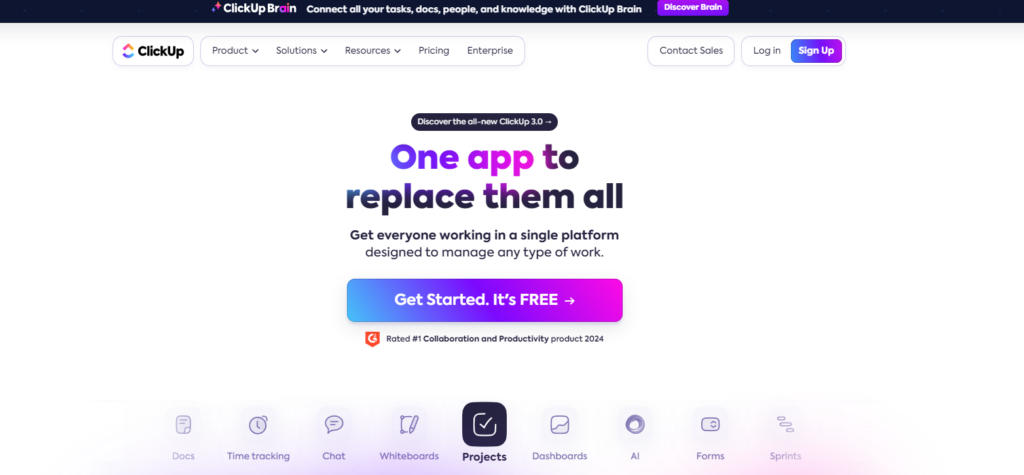
One great example of the self-service model is ClickUp, a SaaS productivity tool that allows customers to explore, sign up, use templates, and all that by themselves. Even better, they completely remove friction by allowing them to sign up completely for free without credit card info.
Their website completely reflects the self-service SaaS sales model.
The Transactional Model
The transactional model sits between the self-service and enterprise models. It targets small—to medium-sized businesses with a more complex product that requires some level of sales interaction to close deals.
This model involves short sales cycles, online demos, and moderate customer support to assist with the buying process. Pricing is usually transparent, and the purchase process can often be completed online with minimal sales assistance.
The transactional model is suitable for products that offer more value or complexity than those typically sold via the self-service model but don’t require the extensive customization and integration of enterprise solutions.
One great example of a transactional model for SaaS sales is Stripe, a well-know payment processing tool.
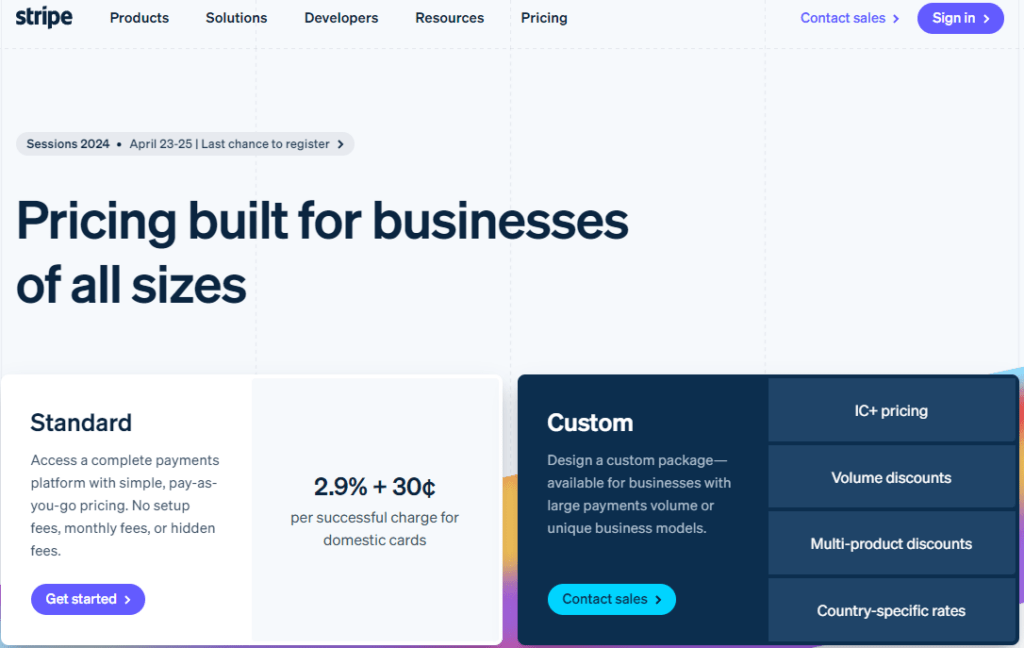
While it’s fairly easy to get started, Stripe has much more friction than ClickUp from the previous example. You have to sign up, complete your business profile, verify that your country supports Stripe, and even verify your business with their employees. During these initial stages, having clear internal processes and using an employee rewards software can help acknowledge the sales and onboarding teams’ efforts, keeping them motivated while they navigate through the verification and setup steps.
The Enterprise Model
The enterprise model is tailored for selling to large organizations and involves a high-touch, consultative sales process. Sales cycles are long, often taking several months, and involve multiple stakeholders.
The process usually includes in-depth demos, pilot programs, and extensive security, integration, and customization discussions to meet the enterprise’s specific needs.
Pricing is rarely listed publicly and is often negotiated based on the deployment scope and customization level. The enterprise model relies on a dedicated sales team, customer success managers, and, often, technical support personnel to facilitate the sale and ensure ongoing satisfaction.
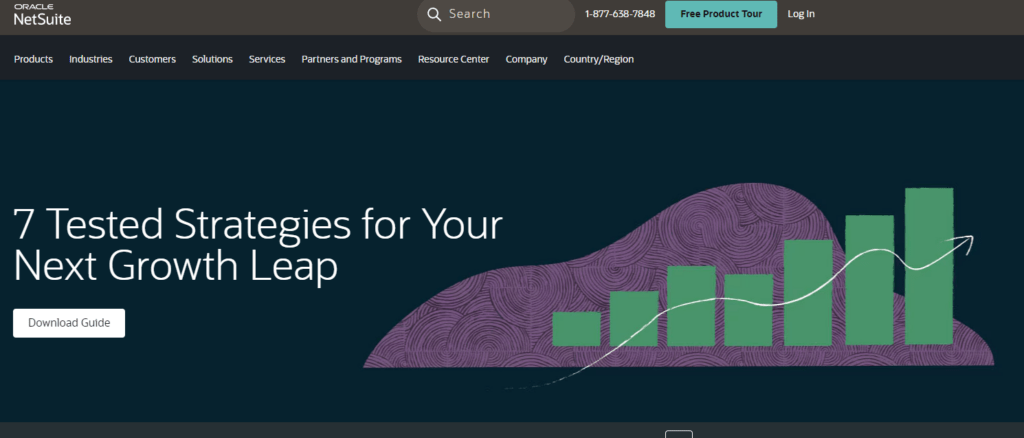
One such example is NetSuite, the ERP software with tons of features available. Naturally, since there are so many customization options, you can’t see the pricing or get started as easily. You can take the free product tour, contact their agents, and after the call you can start setting everything up.
Of course, if you have the budget, since pricing is on the “Get a quote” basis and highly depends on your needs.
How does the Enterprise SaaS Sales Process Differ?
The enterprise SaaS sales process differs significantly from other models due to its complexity, scale, and the strategic nature of the sales approach.
Here are key ways in which it stands out:
Longer Sales Cycles
The enterprise SaaS sales process involves multiple decision-makers and requires approval at various organizational levels, leading to longer sales cycles lasting from a few months to over a year.
Customization and Integration
Enterprises often require solutions to be customized to their specific workflows, integrated with existing systems, and compliant with internal and external regulations. This necessitates a consultative selling approach, where the sales team works closely with the customer to understand their needs and tailor the solution accordingly.
Relationship-Based Selling
Building and maintaining strong relationships is crucial in the enterprise SaaS sales process. Trust and credibility with key stakeholders can significantly impact the sales outcome. Sales representatives often spend considerable time on-site with potential clients, engaging in discussions, conducting workshops, and providing extensive product demonstrations.
Focus on ROI
Enterprise clients must clearly understand the return on investment (ROI) before purchasing. Sales teams must prepare detailed analyses and case studies demonstrating how the software can solve specific business problems, reduce costs, or increase efficiency.
Extensive Post-Sale Support
The relationship with the customer doesn’t end with the sale. Post-sale support, including onboarding, training, and ongoing customer service, is critical to ensure the successful implementation and usage of the software. This level of support is essential for customer retention and facilitates upselling and cross-selling opportunities.
How to Improve Your B2B SaaS Sales Process?
Based on the models and different stages of the process, we’ve got more tips up our sleeves to help you optimize YOUR B2B SaaS sales process. Here we go:
1. Refine Your ICP
If you want to improve your B2B SaaS sales process, start by refining your ICP based on data from your most successful customers. Understanding who your best customers are helps you target similar prospects.
Segmentation can help you with this. You should personalize your marketing efforts to tailor your messaging to your ICP.
2. Invest in Lead and Demand Generation
B2B SaaS SEO services, quality content marketing, and targeted advertising are your best friends when it comes to generating high-quality prospects. Implement lead scoring to focus your efforts on the highest-quality leads.
Let’s imagine your SaaS business has identified several indicators that a lead might be highly qualified, including demographic information, organizational role, and behaviors. Here’s how you can score these leads:
| Industry | Business | Role | Interactions | Channel | Referral |
| +10 points for leads from IT and tech industries | +10 points for enterprises (1,000+ employees) | +15 points for C-level executives (CEO, CTO, CFO) | +5 points for visiting the pricing page | Organic search +10 points. | SaaS affiliate marketing referral: +10 points |
| +5 for the marketing and communications industry | +5 for mid-size companies (250-999 employees) | +10 for directors | +3 for downloading a whitepaper | Paid advertising +5 points. | High-quality referral (e.g., from existing customers): +15 points. |
| 0 for other industries. | +1 for small businesses (10-249 employees) | +5 for managers | +2 for each webinar attended | Social media +3 points. | |
| +2 points for opening an email | |||||
| +5 for clicking through links in emails | |||||
| +20 points for signing up for a free trial | |||||
| +1 point for each return visit to the website within a 30-day period |
And as a conclusion of the lead scoring process, you can get something like this:
| 70+ Points | 40-69 Points | 20-39 Points | Below 20 Points | |
| Description | Sales-ready lead | Marketing-qualified lead | Low priority | Not ready |
| Action | Immediate follow-up with a personal call and customized email. |
Enroll in a nurturing campaign with more targeted content to move them to sales-ready. |
Regular email newsletters and general updates to maintain engagement. |
Monitor for increased engagement before further action. |
3. Shorten the SaaS Sales Cycle
Start by mapping out your entire sales process from lead generation to closing. Track the duration of each stage for a sample of deals to identify where delays tend to occur. Key metrics to analyze include:
- Average time leads stay in each stage.
- Conversion rates between stages.
- Points where leads most frequently drop out or stall.
The next step is to identify common bottlenecks, and the most often are:
- Extended decision-making.
- Inefficient lead qualification.
- Approval delays.
- Complex and lengthy onboarding.
For each bottleneck in the SaaS sales process, you should use these strategies:
- Implement or improve lead scoring systems to better qualify leads early in the process. Use detailed ICPs (Ideal Customer Profiles) to focus efforts on high-potential leads.
- Create clear, concise proposal documents and SaaS ROI presentations to help stakeholders make faster decisions. Consider developing tools like online calculators or interactive demos that help visualize benefits.
- Automate approval workflows within your CRM or sales management tools. Set clear guidelines on who needs to approve what, and at which stages, to reduce waiting times.
- Standardize your B2B SaaS onboarding procedures and prepare resources and training materials beforehand. If possible, offer standardized packages that require less customization but still meet most customer needs.
B2B SaaS Sales Process Examples
Of course, no theory is better than seeing the B2B SaaS sales process in action, so we’ve prepared some examples of well-known B2B SaaS companies:
B2B SaaS Sales Process Example: Slack
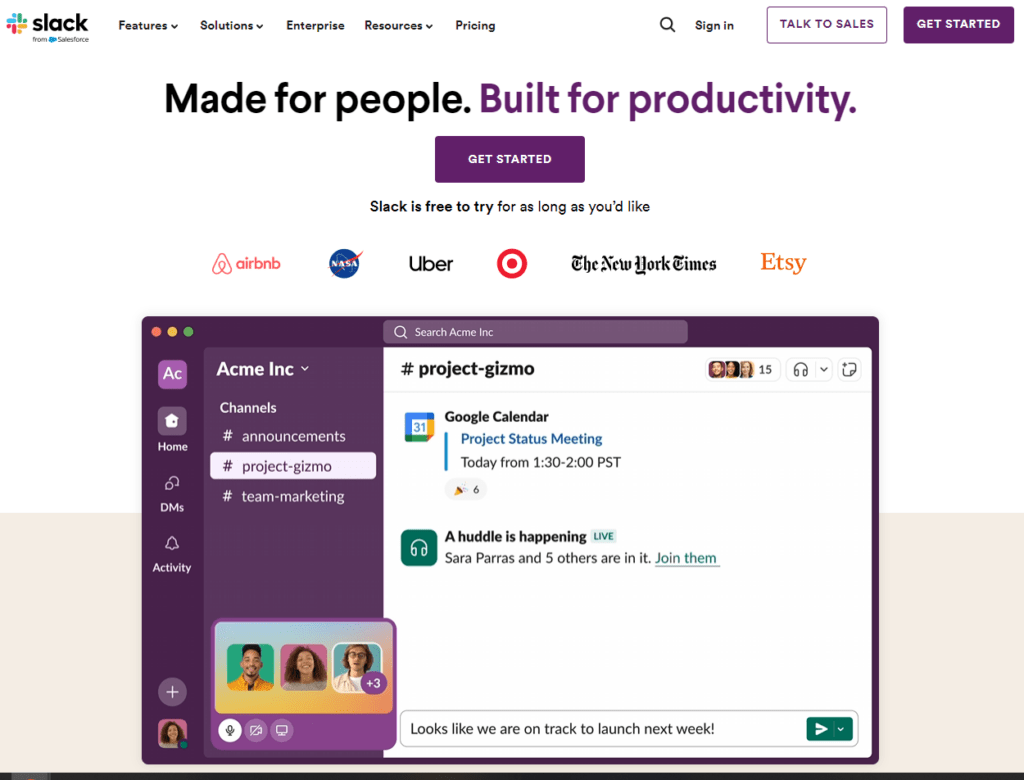
Lead Generation:
Slack utilizes B2B SaaS startup marketing, focusing on productivity and team collaboration benefits. They also leverage word-of-mouth by providing a superior user experience that encourages users to recommend Slack to others.
Lead Qualification:
Slack employs a freemium model that allows users to try the service before buying. This approach helps qualify leads by engaging only those who find value in the platform.
Demo and Product Presentation:
For enterprise clients, Slack offers personalized demos that highlight features relevant to the business’s specific needs.
Proposal and Pricing:
Slack’s pricing is transparent, with clear tiers based on team size and additional features. They offer custom pricing for very large organizations.
Negotiation
While Slack’s pricing is mostly fixed, they do negotiate on service agreements and custom features for large accounts.
Closing the Sale
Slack emphasizes the ease of onboarding and integration with other tools, providing support to ensure a smooth transition for new clients.
Post-Sale and Customer Success
Continuous engagement through webinars, training sessions, and a robust help center ensures customer satisfaction and retention.
B2B SaaS Sales Process Example: Salesforce

Lead Generation
To generate leads, Salesforce uses content marketing, paid advertising, and a strong presence at industry events.
Lead Qualification
By offering a comprehensive demo and a free trial, Salesforce can assess the seriousness and fit of potential customers.
Demo and Product Presentation
Salesforce provides in-depth demos tailored to the prospect’s business size and industry, highlighting how their CRM can solve specific business challenges.
Proposal and Pricing
Salesforce follows up demos with detailed proposals that include pricing, often customized based on the scale and specific needs of the business.
Negotiation
Given Salesforce’s scalability and customization options, negotiation is often part of the sales process, especially for large or complex deployments.
Closing the Sale
Salesforce employs a consultative sales approach, ensuring all stakeholder concerns are addressed before the sale is finalized.
Post-Sale and Customer Success
Salesforce offers extensive training and certification programs, a dedicated account manager, and regular updates to ensure ongoing customer success.
Conclusion
The power lies in knowledge but also in implementation. Knowing all the stages of the SaaS sales process is not enough. You need to dive really deep and analyze how everything rolls out in your B2B SaaS company and then, equipped with data, improve the processes.
It’s easier said than done, but you have some actionable tips and perfect examples of how the SaaS sales process rolls out in widely popular companies. Step-by-step, stage by stage, you’ll have to analyze, test and tweak until your sales process becomes enough to increase your ARR, year over year.
And you can’t take shortcuts, unfortunately. Some decisions you make will be hit or miss, but by understanding and refining each stage, leveraging insights to optimize lead scoring, streamlining negotiations, and accelerating the sales cycle, we’re confident you’ll get there.
And when you want to get more qualified leads and fill your sales pipeline, Nuoptima, and its B2B SaaS SEO services will give you exactly what you’re looking for!
Let’s check out and answer FAQs your peers usually have about the B2B SaaS sales process:
FAQ
B2B SaaS sales involve selling SaaS solutions to small, medium, and large businesses. Sales reps involved in SaaS sales focus on generating and converting new leads or retaining existing clients through upselling.
There are 7 stages of a SaaS sales process:
- Lead and Demand Generation
- Lead Qualification
- Discovery
- Solution Presentation
- Negotiation
- Closing
- Onboarding and Implementation
Research conducted by Hubspot indicates that the typical sales cycle for SaaS software spans 84 days.
Check out this insightful discussion on SaaS sales strategies in the Nuoptima SaaS Podcast featuring Jeff Whitlock.
References
- https://explodingtopics.com/blog/saas-statistics [1]
- https://www.statista.com/statistics/1367691/b2b-saas-organic-paid-cpl-united-states/#:~:text=Between%20January%202018%20and%20November,CPL%20reached%20almost%20165%20dollars. [2]
- https://firstpagesage.com/reports/roas-statistics/ [3]
- https://www.klipfolio.com/resources/kpi-examples/digital-marketing/mql-to-sql-conversion-rate [4]
- https://www.navattic.com/report/state-of-the-interactive-product-demo-2024 [5]
- https://gitnux.org/customer-onboarding-statistics/ [6]

